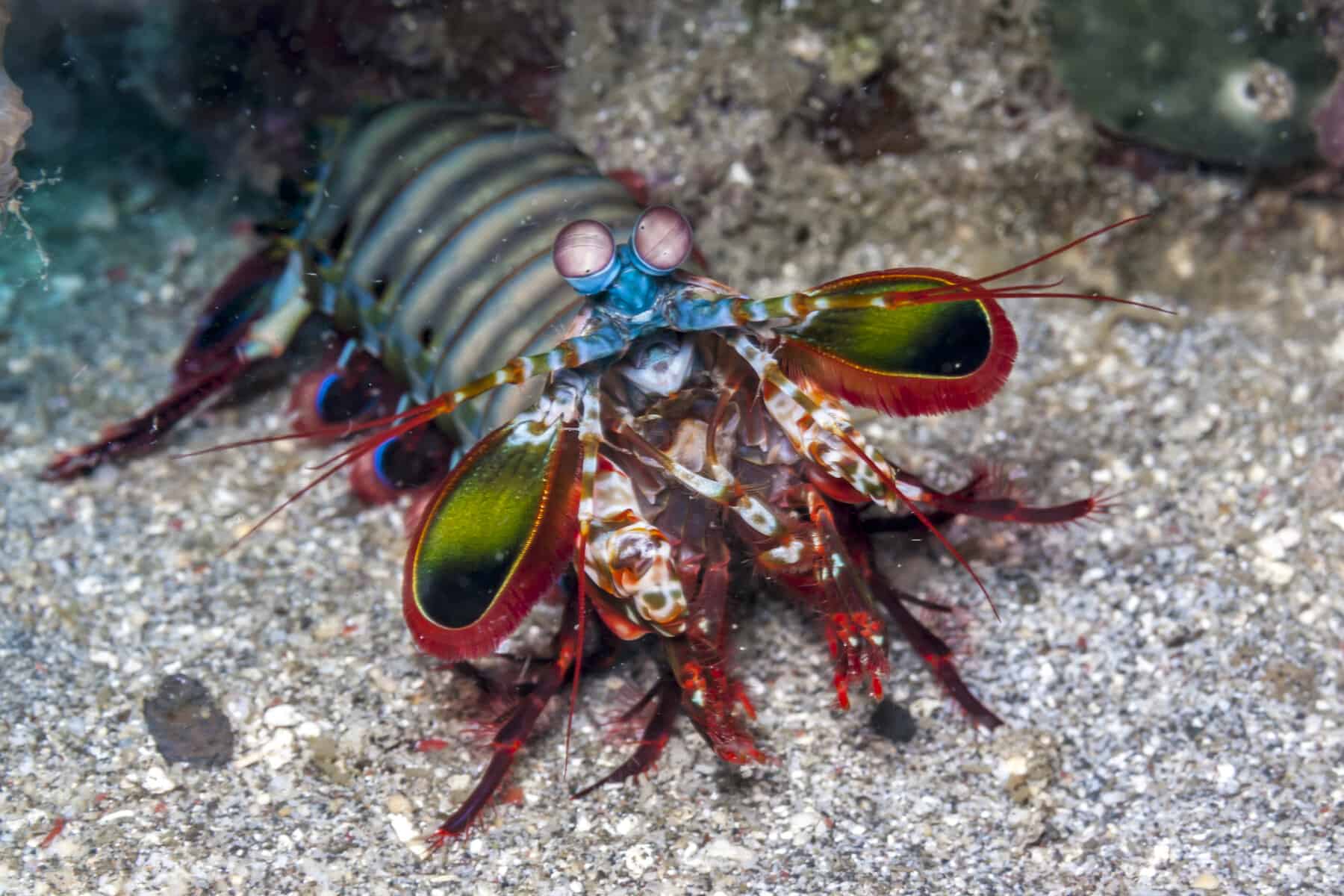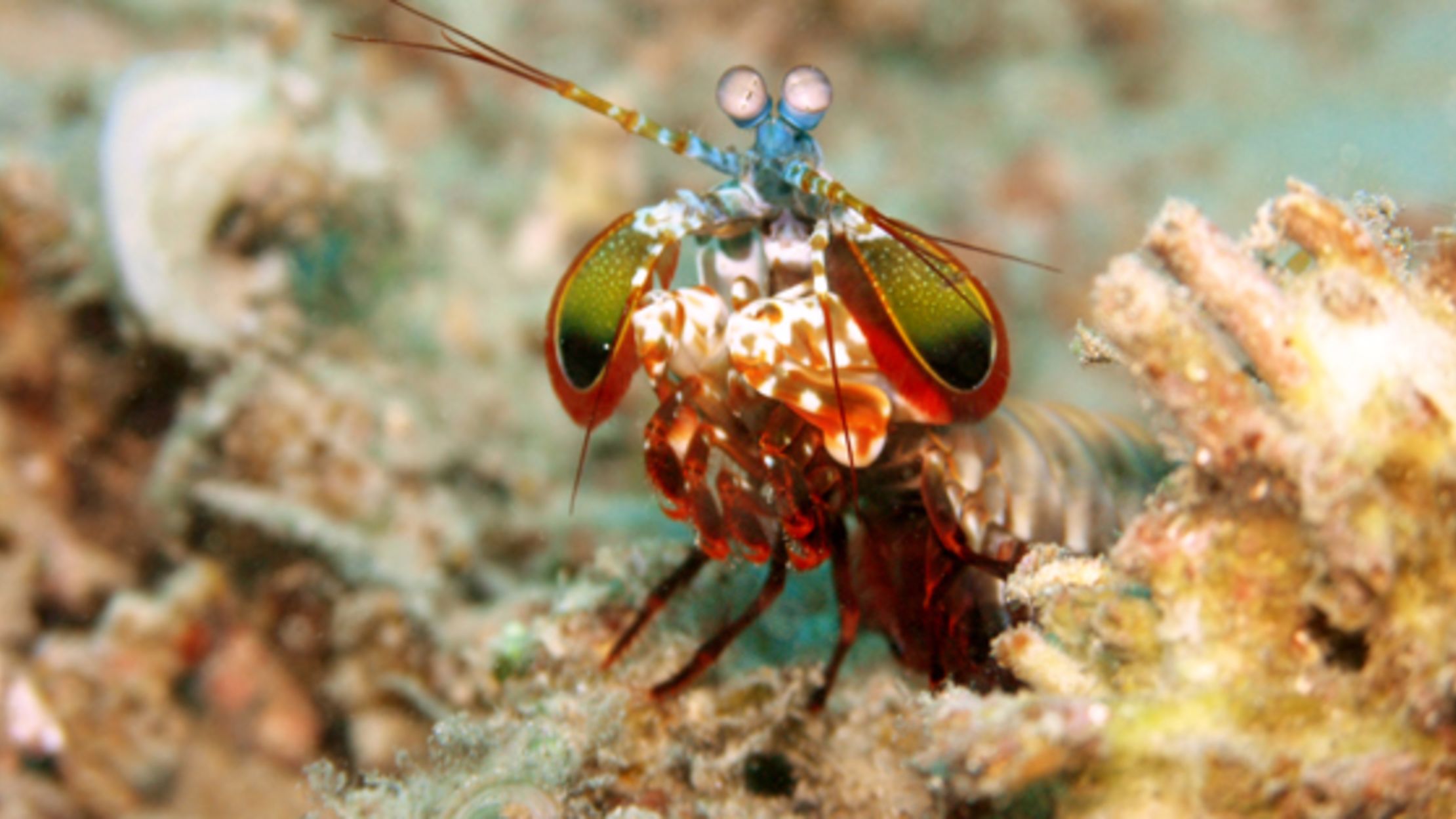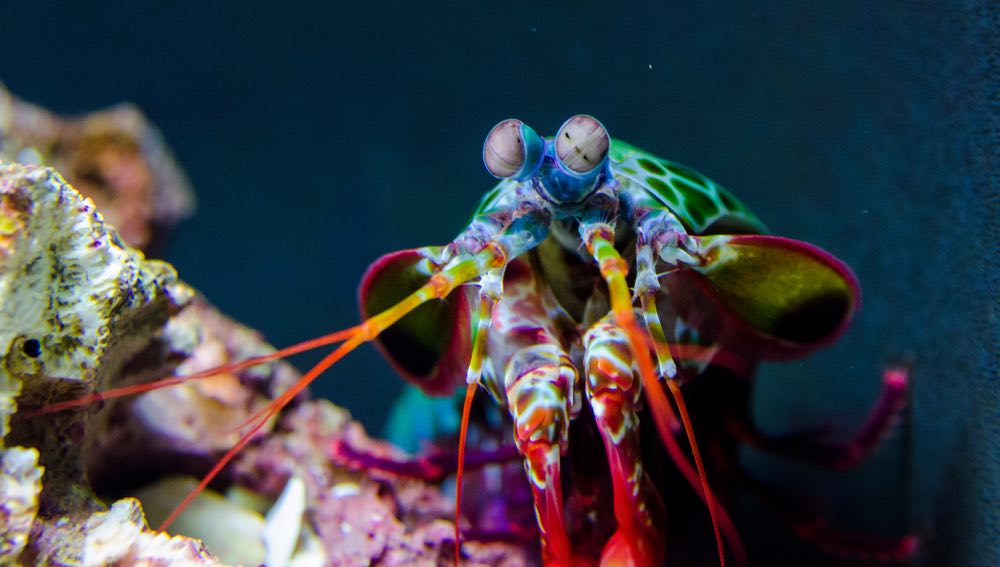
Shrimp That Can Break Glass The Beautiful Mantis Shrimp
Mantis shrimp are ambush predators and need places to hide. In general, a sandy substrate at the bottom of the tank is preferable. If you are planning to keep a 'Spearer' Mantis shrimp, the sand becomes mandatory. Sand bed should be at least 1.5 times as deep as the animal is long.

Praying Mantis Shrimp under glass dome Quollastria Catawiki
Peacock mantis shrimp can be found at depths of 3-40 m, though they are most typically found at depths of 10-30 m. They prefer water temperatures of 22-28°C. These mantis shrimp are most commonly found in their U-shaped burrows, often built near the bases of coral reefs on sandy and gravelly areas. (Baxamusa, 2010; Caldwell, 2006) Habitat Regions

U34A Taxidermy Mantis Shrimp Glass Dome Display Oddities Etsy
Despite being 18 inches, this species has 1,500 N punch which. https://ofacts.org/invertebrates/mantis-shrimp-facts/

U34A Taxidermy Mantis Shrimp Glass Dome Display Oddities Etsy
The mantis shrimp possesses two incredibly strong arms that it uses to eat attack and eat its prey. Destin from Smarter Every Day, visits Australia to discover how the mantis shrimp uses physics to generate enough power to break through glass and crab shells.

U34A Taxidermy Mantis Shrimp Glass Dome Display Oddities Etsy
What do you think???? Yes or NoBy Paul Talbot http://paultalbot.com.au/Links for more information and prices:http://www.majesticaquariums.com.au/Contact.aspx

How Does the Mantis Shrimp Break Glass Without Hurting Itself? Mental Floss
Today we are going to discuss Mantis Shrimp breaking glass, how and why it actually happens. The appendages on a mantis shrimp aren't used for cutting and crushing like a praying mantis. Instead, these appendages, called dactyl clubs, are used for smashing and battering. They use these club-like appendages to batter shellfish until their.

Kann Mantis Shrimp Aquarium Glas zerbrechen?
But sometimes, the 7-inch-long shrimp wields its clubs to TKO a tougher foe: aquarium glass. It's no surprise that it's possible; this shrimp packs a punch that accelerates to 50mph and.

Mantis Shrimp attacking snail / hitting glass! YouTube
The Mantis Shrimp (or 'Stomatopod') is a small, aggressive marine Crustacean, that inhabit tropical and subtropical waters of the Indian and Pacific Oceans between Eastern Africa and Hawaii.. They have also been known to attack their own reflection through the glass. 5. Their clubs have a special shock absorbent core which stops them.

Mantis Shrimp BREAKING GLASS YouTube
In 1998, a four-inch mantis shrimp named Tyson smashed through his aquarium tank's quarter-inch-thick glass. — National Geographic Up to a month after fighting a rival, a mantis shrimp can.

U34A Taxidermy Mantis Shrimp Glass Dome Display Oddities Etsy
The question of whether intentionally adding a mantis shrimp to a fish-only or reef tank is bad, the answer to this is an unequivocal, yes!. If you do put one in an aquarium with other animals, don't get mad at the shrimp if things start disappearing. If you decide you want to buy a mantis shrimp or keep one, because of its territorial and.

How Do Mantis Shrimp Break Glass? Facts & FAQs Hepper
The Secret of the Glass-Cracking Mantis Shrimp Jun 01, 2016 at 2:12 PM EDT . The unique "herringbone" structure of a mantis shrimp claw allows it to withstand enormous force without breaking.

U34A Taxidermy Mantis Shrimp Glass Dome Display Oddities Etsy
The mantis shrimp has compound eyes mounted on stalks, and can swivel them independently of one another to survey its surroundings. While humans have three types of photoreceptors, a mantis shrimp's eyes have between 12 and 16 types of photoreceptor cells. Some species can even tune the sensitivity of their color vision.

Mantis Shrimp marine crustaceans swimming underwater glass aquarium tank Stock Photo Alamy
Mantis shrimp hold the title for the fastest punch in the animal kingdom—powerful enough to break seashells and aquarium glass. They also boast some of the world's most complex, extraordinary.

U34A Taxidermy Mantis Shrimp Glass Dome Display Oddities Etsy
They will also eat the other animals in the tank, and can potentially break the glass of the aquarium. Mantis Shrimp Care. More experienced aquarists can house mantis shrimp in aquariums. The peacock mantis is the most popular species in aquariums because they are quite colorful. They require rock or sand to tunnel in, and prey to feed on.

U34A Taxidermy Mantis Shrimp Glass Dome Display Oddities Etsy
The Mantis Shrimp will grow on average between 5 to 7 inches. The maximum size for a Mantis Shrimp is around 15 inches. A 7-inch Mantis Shrimp can easily break a normal 10-gallon glass tank. If a 7-inch shrimp can demolish a 10-gallon tank, imagine what a larger one could do. If I were you, I wouldn't house the Mantis Shrimp in a glass tank.

Peacock Mantis Shrimp Borosilicate Glass Sculpture (Odontodactylus scyllarus) A.K.A. Harlequin
Mantis shrimp are a type of stomatopod, which is a class of marine crustaceans. They are also known as "thumb splitters" due to their powerful punches, which can break through hard shells and even aquarium glass. Mantis shrimp come in a variety of colors and sizes, with some species growing up to 30 centimeters in length.